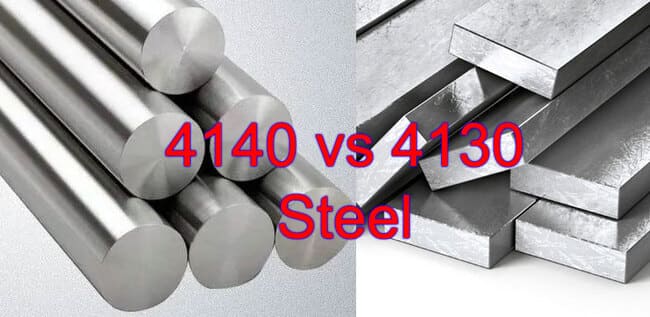4140 and 4130 steels are often compared due to their popularity and similar composition within the 41xx category. In this blog post, we will go through the comparison of 4140 vs 4130 steel, exploring their properties, applications, and the factors to consider when choosing between them.
Understanding 41xx Category
Both 4140 and 4130 steels belong to the 41xx category, which consists of chromium and molybdenum alloy steels. These alloys offer superior strength and toughness compared to regular steel.
Although they contain chromium, they do not possess the corrosion-resistant properties of stainless steel. However, they are highly durable and exhibit excellent mechanical characteristics.

4140 Steel
4140 steel is a low alloy steel with a carbon content ranging from 0.38% to 0.43%. In addition to carbon, it contains elements such as manganese, phosphorus, sulfur, silicon, chromium, and molybdenum. This steel variant is renowned for its exceptional strength, toughness, and machinability.
Some key properties of 4140 steel include:
Hardness and Extreme Ductility
Due to its higher carbon and chromium content, 4140 steel boasts a high tensile strength of 148,000 PSI. It can withstand heavy loading conditions without breaking and exhibits remarkable ductility, making it easy to draw into wires.
Anti-Corrosion Property
While 4140 steel is susceptible to rust, it demonstrates high resistance to corrosion.
Machinability
4140 steel is known for its good machinability, making it suitable for various rapid prototyping operations such as CNC machining and sheet metal fabrication. However, welding this steel can be challenging, requiring heat treatment before the welding process.
The applications of 4140 steel span across different industries, including the manufacturing of gears, crankshafts, sprockets, and more.
4130 Steel
4130 steel is another low alloy steel that contains a carbon content ranging from 0.28% to 0.33%. It shares similarities with 4140 steel in terms of its composition, including elements such as manganese, phosphorus, sulfur, silicon, chromium, and molybdenum. The key properties of 4130 steel are as follows:
Mechanical Properties
Like 4140 steel, 4130 steel exhibits impressive tensile strength, measuring 97,200 PSI, and a C20 rating on the Rockwell hardness scale. It also possesses excellent ductility in its annealed state, allowing for easy wire drawing.
Elasticity
4130 steel demonstrates a high modulus of elasticity, enabling it to endure significant strain while returning to its original shape.
4130 steel finds applications in various industries, particularly in the automotive sector, where it is used to manufacture gears, drill bits, cutting tools, and more.
Comparison of 4140 vs 4130 Steel
While 4140 and 4130 steels share similarities, it’s important to understand their differences to make an informed choice for your project.
chemical properties of 4140 and 4130 steel:
| Property | 4140 Steel | 4130 Steel |
|---|---|---|
| Carbon (C) | 0.38% – 0.43% | 0.28% – 0.33% |
| Manganese (Mn) | 0.75% – 1.00% | 0.40% – 0.60% |
| Phosphorus (P) | 0.035% (max) | 0.040% (max) |
| Sulfur (S) | 0.040% (max) | 0.040% (max) |
| Silicon (Si) | 0.15% – 0.35% | 0.15% – 0.35% |
| Chromium (Cr) | 0.80% – 1.10% | 0.80% – 1.10% |
| Molybdenum (Mo) | 0.15% – 0.25% | 0.15% – 0.25% |
| Iron (Fe) | Remainder | Remainder |
Here are some key factors to consider:
- Strength and Toughness: Both steels offer excellent strength and toughness, but 4140 steel surpasses 4130 steel in terms of tensile strength.
- Machinability: Both steels are machinable, but welding 4140 steel requires heat treatment, whereas welding 4130 steel is relatively easier.
- Applications: 4140 steel is commonly used in the manufacturing of gears, crankshafts, and sprockets, while 4130 steel is widely utilized in the automotive industry for gears, drill bits, and cutting tools.
- Cost: The cost of 4140 and 4130 steel can vary, so it’s essential to consider your budget when selecting the appropriate steel grade.
Conclusion
In the comparison of 4140 vs 4130 steel, both steel grades offer exceptional properties and find applications across various industries. While 4140 steel demonstrates superior tensile strength, 4130 steel is known for its ease of welding.
Understanding your project requirements, including strength, machinability, and budget, will help you choose the right steel grade for optimal performance. Whether it’s gears, crankshafts, or automotive components, selecting the appropriate steel will ensure the success of your project.
